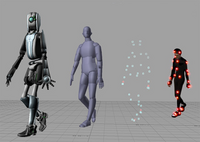
Photo from wikipedia
Rapid developments in augmented reality (AR) and related technologies have led to increasing interest in immersive content. AR environments are created by combining virtual 3D models with a real-world video… Click to show full abstract
Rapid developments in augmented reality (AR) and related technologies have led to increasing interest in immersive content. AR environments are created by combining virtual 3D models with a real-world video background. It is important to merge these two worlds seamlessly if users are to enjoy AR applications, but, all too often, the illumination and shading of virtual objects is not consider the real world lighting condition or does not match that of nearby real objects. In addition, visual artifacts produced when blending real and virtual objects further limit realism. In this paper, we propose a harmonic rendering technique that minimizes the visual discrepancy between the real and virtual environments to maintain visual coherence in outdoor AR. To do this, we introduce a method of estimating and approximating the Sun’s position and the sunlight direction to estimate the real sunlight intensity, as this is the most significant illumination source in outdoor AR and it provides a more realistic lighting environment for such content, reducing the mismatch between real and virtual objects.
Journal Title: Multimedia Tools and Applications
Year Published: 2019
Link to full text (if available)
Share on Social Media: Sign Up to like & get
recommendations!